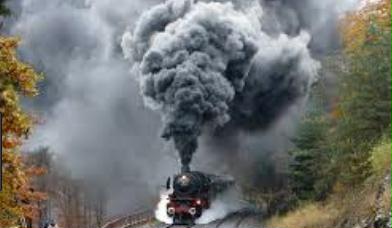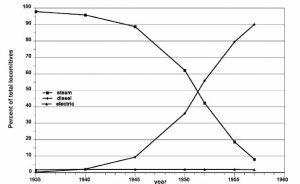 Preface. At some point of fossil fuel decline future generations will be tempted to build steam engines again, and perhaps just as in America initially they’ll use wood to fuel the engines, since coal will be scarce at some point (steamships didn’t burn coal until 1850 when iron ships first appeared). A good thing coal came along — burning wood in steam engines for locomotives, steam ships, factories, tractors, and other uses decimated America’s forests.
Preface. At some point of fossil fuel decline future generations will be tempted to build steam engines again, and perhaps just as in America initially they’ll use wood to fuel the engines, since coal will be scarce at some point (steamships didn’t burn coal until 1850 when iron ships first appeared). A good thing coal came along — burning wood in steam engines for locomotives, steam ships, factories, tractors, and other uses decimated America’s forests.
Steam engines are a great deal less efficient than internal combustion engines, making a recovery to today’s level of civilization unlikely.
Alice Friedemann www.energyskeptic.com author of “When Trucks Stop Running: Energy and the Future of Transportation”, 2015, Springer and “Crunch! Whole Grain Artisan Chips and Crackers”. Podcasts: Derrick Jensen, Practical Prepping, KunstlerCast 253, KunstlerCast278, Peak Prosperity , XX2 report
***
Ayres, R.U., et al. March 2003. Exergy, power and work in the US economy, 1900-1998. Energy Vol 28 #3 219-273.
During the first half of the century (1900-1950) steam locomotives for railroads were the major users, with stationary steam engines in mines and factories also significant contributors.
Steam turbine design improvements and scaling up to larger sizes accounted for most of the early improvements. The use of pulverized coal, beginning in 1920, accounted for major gains in the 1920s and 30s. Better designs and metallurgical advances permitting higher temperatures and pressures accounted for further improvements in the 1950s. Since 1960, however, efficiency improvements have been very slow, largely because existing turbine steel alloys are close to their maximum temperature limits.
The conversion efficiency of steam–electric power plants has increased by nearly a factor of ten, from 3.6% in 1900 or so to nearly 34% on average (including distribution losses) and 48% for the most advanced units. The consumption of electricity in the US has increased since 1900 by a factor of 1200, and continued to increase rapidly even after 1960.
In the case of large stationary or marine steam engines operating under optimal conditions at constant loads, the thermal efficiency exceeded 15% in the best cases. However, locomotive steam engines were not nearly so efficient — between 4% and 8% on average — and the best locomotive engine in 1900 achieved around 11%, increasing to perhaps 13% by 1910
Factory engines were generally older and even less efficient and transmission losses in factories (where a central engine was connected to a number of machines by a series of leather belts) were enormous. For instance, if a stationary steam engine for a factory with machines operating off belt drives circa 1900 had a thermal efficiency of 6%, with 50% frictional losses, the net exergy efficiency was 3%. The Dewhurst estimate, which took into account these transmission losses, set the average efficiency of conversion of coal energy into mechanical work at the point of use at 3% in 1900 (when most factories still used steam power) increasing to 4.4% in 1910 and 7% in 1920, when the substitution of electric motors for steam power in factories was approaching completion. The use of steam power in railroads was peaking during the same period.
In the case of railroad steam locomotives, average thermal efficiency circa 1920 according to another estimate was about 10%, whereas a diesel electric locomotive half a century later (circa 1970) achieved 35%. Internal friction and transmission losses and variable load penalty are apparently not reflected in either figure, but they would have been similar (in percentage terms) in the two cases. If these losses amounted to 30%, the two estimates are consistent for 1920. Coal-burning steam locomotives circa 1950 still only achieved 7.5% thermal efficiency; however, oil-burning steam engines at that time obtained 10% efficiency and coal-fired gas turbines got 17%. But the corresponding efficiency of diesel electric locomotives c. 1950 was 28%, taking internal losses into account. The substitution of diesel–electric for steam locomotives began in the 1930s and accelerated in the 1950s.
The work done by internal combustion engines in automobiles, trucks and buses (road transport) must be estimated in a different way. In the case of heavy diesel-powered trucks with a compression ratio in the range of 15–18, operating over long distances at highway speeds, the analysis is comparable to that for railways. The engine power can be optimized for this mode of operation and the parasitic losses for a heavy truck (lights, heating, engine cooling, air-conditioning, power- assisted steering, etc.) are minor. Internal friction and drive-train losses and losses due to variable load operation can conceivably be as low as 20%, though 25% is probably more realistic.
In the case of railroads the traditional performance measure is tonne–km. From 1920 to 1950 the improvement by this measure was threefold, most of which was due to the replacement of coal-fired steam locomotives by diesel–electric or electric locomotives. This substitution began in the 1930s but accelerated after the second World War because diesel engines were far more fuel-efficient — probably by a factor of five.
According to a study published in 1952, diesel engines can perform ten times as much work as steam engines in switching operations, five times as much in freight service and three times as much in passenger service. The overall gain might have been a factor of about five — and also required significantly less maintenance. But from 1950 to 1960 the service output (measured in vehicle–km traveled) per unit exergy input quadrupled and from 1960 to 1987 there was a further gain of over 50%. The overall performance increase from 1920 to 1987 by this measure (tonne–km per unit of fuel input) was around 20-fold. In 1920 US railways consumed 122 million tonnes of coal, which was 16% of the nation’s energy supply. By 1967 the railway’s share of national energy consumption had fallen to 1% and continued to decline thereafter.
It is obvious that much of the improvement has occurred at the system level. One of the major factors was that trucks took over most of the short-haul freight carriage while cars and buses took most of the passengers, leaving the railroads to carry bulk cargoes over long distances at (comparatively) high and constant speeds and with much less switching — which is very exergy intensive. Under these conditions the work required to move a freight train is reduced because rolling friction and air resistance are minimized, while work required for repeated accelerations and decelerations was sharply reduced or eliminated.
Another factor behind the gains was that the work required to overcome air and rolling resistance had been reduced significantly by straightening some of the rights-of-way, improving couplings and suspensions, and introducing aerodynamic shapes. A third source of gain was increasing power-to-weight ratios for locomotives; locomotives in 1900 averaged 133 kg/kW. By 1950 this had fallen to about 33 kg/kW and by 1980 to around 24 kg/kW. The lighter the engine, the less power is needed to move it. (This is an instance of dematerialization contributing to reduced exergy consumption.) If the railways in 1987 were achieving 30% thermal efficiency, and if the coal-fired steam locomotives of 1920 were averaging 7% (for an overall factor of four and a fraction), then an additional factor of five or so was achieved by increasing system efficiency in other ways. In effect, the work required to haul rail cargoes has declined dramatically since 1960, but the exergy input required per unit of mechanical work done has hardly changed since then.

Substitution of diesel for steam locomotives in the USA, 1935–1957.

3 Responses to Steam engines. Exergy power. and work in the US